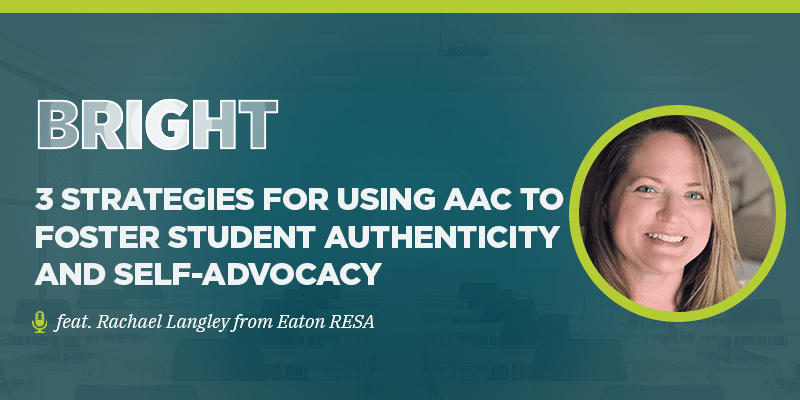Or listen on Apple, Spotify, Google, or another platform. Alternatively, you can read along with the transcript.
In 2016, a group of experts came together to create the communication bill of rights. This list includes 15 fundamental human rights that every person has with regard to communication. A few examples include:
The right to request desired objects, actions, events, and people
The right to refuse or reject undesired objects, actions, events, or choices
The right to be addressed directly and not be spoken for or talked about in the third person while present
The concept here is that everyone — including those with severe disabilities and/or complex communication needs — has the right to communicate their thoughts and feelings.
“The disability rights movement is kind of one of the last human rights movements to push forward,” says Rachael Langley, a speech-language pathologist and an AAC consultant for Eaton RESA. “It sounds so obvious, but we have to believe at our core that everyone has thoughts and feelings regardless of their perceived abilities or their disability.”
For students with complex communication needs, the technology available today to help express their thoughts and feelings is better than ever before. This technology is broadly referred to as AAC — augmentative and alternative communication — and it can help students recover their right to communicate when their verbal speech cannot fully express their thoughts and feelings.
In this episode of the BRIGHT podcast, I chat with Rachael, and, together, we explore:
- What AAC is and why this technology is so important for students who have limited verbal speech to express all their thoughts.
- Why the ability to communicate is a fundamental human right, particularly being able to express our needs and to say no.
- Rachael’s top three strategies for using AAC to foster authenticity and self-advocacy among students.
Of course, we understand that educators are busier than ever. If you don’t have time to listen to Rachael’s full episode (which offers the fuller effect of her wisdom, energy, and examples), you can still benefit from a glimpse at her top three tips for using AAC to foster student authenticity and self-advocacy.
3 strategies for using AAC to foster student authenticity and self-advocacy
- Give students access to a LOT of words.
This one may seem counterintuitive at first. When working with students with complex communication needs, it may seem like a good idea to start with a small vocabulary list and then expand it.
According to Rachael, however, this is a common misconception.
“Sit next to a typically developing four-year-old for a while and think how many words they say in an hour,” she says. “Avoid that roadblock of wanting to limit or pick the words for someone else. That’s way too much responsibility.”
As children develop linguistically, they need space to babble, practice, and play with many word combinations.
- Use AAC technology yourself when communicating with the student.
When working with a student who uses an AAC device, it can be helpful for you to practice using this technology to communicate with your student. This simple practice can yield many benefits.
First off, it reduces the communicative burden on the learner who is typically required to code-switch between the adult’s natural speech and their AAC tool.
Next, it can help model for the student how to translate between verbal speech and the options available on their device.
Last but not least, it can help foster empathy between adults and students. The adult gets a glimpse into what it is like to navigate this complicated device, and the student sees the adult struggling to learn alongside them.
- Build opportunities for students to say “no” in safe ways.
The right to refuse is a core communication right. If a student enjoys pressing their “no” button often, it may be tempting to limit children from the ability to use this particular button. But saying “no” is not only a fundamental human right, but it is also an integral part of the developmental process.
If you have doubts about this, consider toddlers, who often seem to enjoy exercising this right religiously. Because children with complex communication needs are an incredibly vulnerable population, compliance-based instruction models can become dangerous when they reinforce the message that it’s not okay to say “no.”
Part of learning language is learning how to use this powerful gift responsibly. A student’s refusal to participate may not be appropriate to grant in a situation where their clothing is soiled, or they need to get on the bus to go home.
Still, it is important to build opportunities for choice into the school day so children can practice saying “no” in safe ways. These little moments can be as simple as “Would you like to sit here?” or “Would you like the purple cup?”
My favorite quotes from this episode
“The disability rights movement is one of the last human rights movements to push forward. It sounds so obvious, but we have to believe at our core that everyone has thoughts and feelings regardless of their perceived abilities or their disability.”
“The real aha moment and the piece that grabs you is when… they give that look of ‘Yeah, that’s what I meant.’ It affirms that they understand the purpose of the tool and that they now have another way to get their message out without waiting for an adult to guess what they need. That moment, that spark — whether it’s in their eyes or a little smile — is really what fuels me because so many of our kids can’t tell us in the same way what they’re thinking or if we’re on the right track. I see that little spark even in some of my students who have very little muscle control over their bodies. It could even be this little eyebrow twitch of like, ‘Ah, yes, that’s what I meant.’ That’s what fuels me to keep going.”
“We have to think about the potential danger of teaching a compliance based-model to students who are already pretty vulnerable. We don’t want to teach them that their job is to do what adults tell them to do. Their job is to use their words to tell us what they want or don’t want.”
“‘Complex communication needs’ is a term that the population themselves came up with. They were saying: ‘We don’t want to be called nonverbal. Nonverbal means non-speaking and can imply non-thinking. But we have complex needs. We have ideas. We have thoughts, and we can get them out in some way.’”
Related resources
- Learn: The communication bill of rights
- Attend: #TalkingAAC conference
- Learn: Project core
- Watch: The first pizza ordered with a computer through MSU’s Artificial Language Lab
- Watch: TEDxMacatawa – Chris Klein – Seeing unique abilities
- Contact Rachael: Reach language

